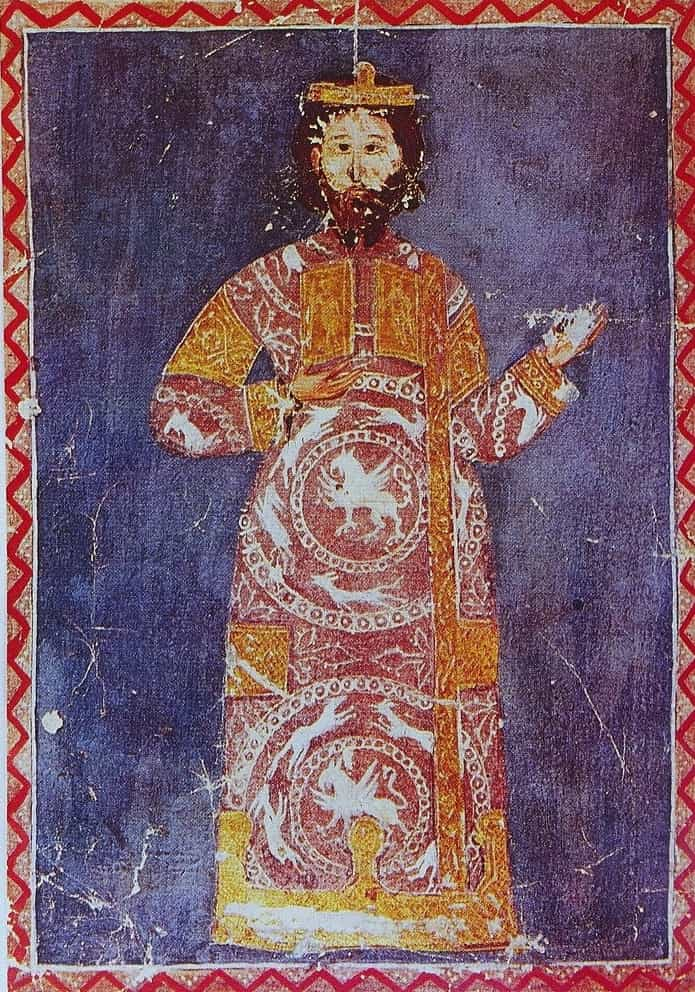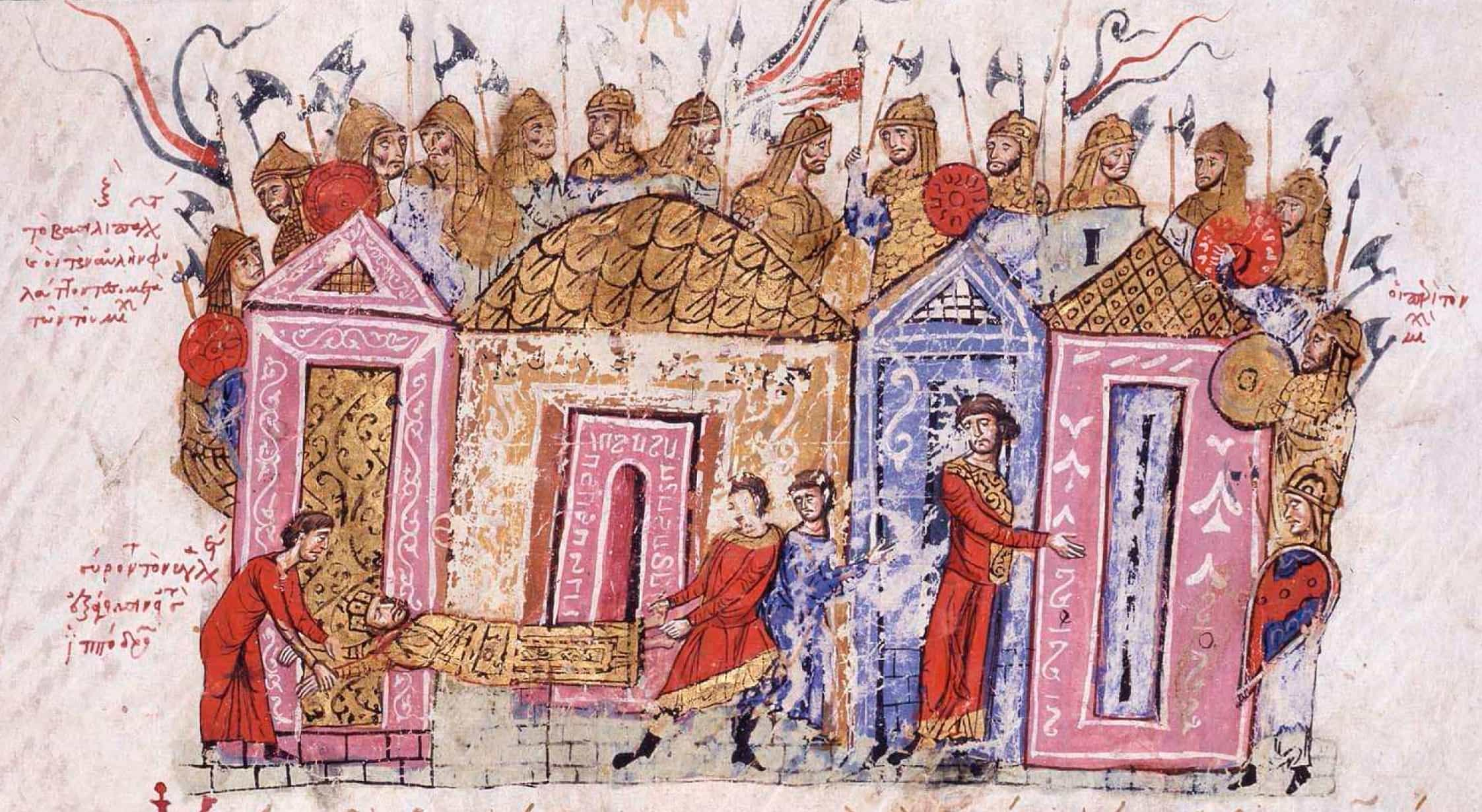Basileios II (reigned 976–1025), ruler of Byzantium, was in a tight spot. Not long after ascending to the throne at the tender age of 19, two strong military commanders rose up in open rebellion. It took the youthful ruler three years and a bloody battle to put down the rebellion. To obtain a guard as powerful as it was loyal, Basil II of Byzantium made a pact with Kievan Rus. He received 6,000 Varangians in exchange for his sister’s marriage to ruler Vladimir I. With this force, he restored the empire.
In 987, a rebellious general named Bardas Phokas declared himself emperor, took over nearly all of Asia Minor, and then turned his attention to Constantinople, which was the capital of the Byzantine Empire and the largest city in Europe at the time. This was the second time that the power of Basil II was put to the test.
To protect the monarchy, Basil II saw no choice but to seek assistance from elsewhere. Vladimir I or Vladimir the Great (r. 980–1015) of Kievan Rus, a kingdom established in the 9th century by Varangian and Norsemen from Sweden, was the one he consulted.
Vladimir, a Viking descendant, ruled an expansive region that spanned from the northwestern Russian lake of Ladoga to the south of Kiev and from the eastern borders of Poland and Lithuania to the higher stretches of the Volga River.
Vladimir’s power was based on force. In 980, he hired 6,000 Swedish soldiers to help him crush his enemies. The word “Varangians” was coined to differentiate these recently arrived indigenous Scandinavians from the more established Russians of northern European descent. The term likely comes from the Old Norse word “vár,” which means “vow,”. The word comes from the Norse way of putting together groups of sworn warriors.
A Call for Help from the Byzantine Emperor

Vladimir owes his position now to the Varangians, but he quickly ran into trouble when he discovered he could not pay them. This made it imperative that he eliminate them before they became a danger. The call for help from Byzantium came just in time.
Given how bad his situation was, Emperor Basil II gave Vladimir his sister Anna as a trade for the Varangians’ help. In exchange, Vladimir, a pagan, was required to undergo an Orthodox Christian baptism. And so the Russian Empire became a Christian one.
In 988, Swedish soldiers boarded ships and sailed 2000 kilometers down the Dnieper to the Black Sea and on to Byzantium. The fresh recruits were put to the test on April 13, 989. Basil II planned a showdown with the rebel Bardas Phokas at Abydos in Asia Minor.
The general was riding a horse at the head of his army when he suddenly lost his balance and fell off his horse as he raced toward Basil II to fight him. It’s possible he had a cardiac attack. For what it’s worth, the Varangians immediately charged the dead general and finished him off.
They delivered the severed skull to Emperor Basil II, who put it on public exhibit as a trophy and a constant reminder of what had happened. The uprising soon died for lack of a strong commander.
Basil II liked the Norsemen so much that he put together a security team made up of the best warriors to protect them. This elite force came to be known as the Varangian Guard. It probably consisted of 6,000 soldiers, divided into twelve divisions of 500 men. However, the leader of this group, known as the Akolouthos, was typically a Byzantine and not a Viking. He was second only to the Emperor in importance and walked in line right behind him.
The main job of the Varangian Guard was to keep the monarch safe at all times from all kinds of dangers. It also served as a sort of elite security force in Constantinople, putting down uprisings and murdering alleged traitors. The Varangians could be relied on to carry out their tasks without showing favoritism to the rank or family links of their victims because they had no interaction with the locals and were therefore not engaged in local intrigues.
Varangians Were Effective Shock Troops for Surprise Attacks
Northern males had no use for Greek and no interest in learning it. It’s clear that the emperor wanted as little interaction as possible between his soldiers and the common people. Only the monarch, or Akolouthos, could communicate with the Varangians directly because only he could understand their language.
The emperor used them in battle as “shock troops,” which were very effective because they attacked quickly and hard. The two-handed combat axe was their weapon of preference, leading to the moniker “axe-wielding barbarians of the emperor.” Or, “wine-drinking warriors of the monarch,” a reference to their extreme thirst. All told, each man got about 40 gold pieces as payment, plus a cut of the battle loot.
Basil II sent his Norse soldiers to Syria, Georgia, Greece, Armenia, Italy, the Balkans, and other places in the Middle East, Europe, and Africa. As a result of their combat skills, he became known as the “Bulgarian Killer” in history. By the time he died in 1025, the area under Byzantine rule had grown from southern Italy across the Adriatic and what is now Turkey to Antioch in the Middle East and Armenia.
For the next 180 years, each new emperor knew how important the Varangians were to keeping the power of the empire and didn’t want to do without their help. They gained notoriety for their unwavering devotion and intrepidity.
The Byzantines lost horribly to the Turkish Seljuks at the Battle of Manzikert in eastern Turkey in 1071. While many Byzantine troops left the field, the Varangians battled until the bitter end and sacrificed themselves for Emperor Romanos IV (Romanos IV Diogenes), who was caught and humiliated by his enemies.
Those Varangians who made it through their duty, however, came back to their homeland as wealthy men. When Bolli Bollason, an Icelander, landed on the island in the middle of the 11th century, he created quite a stir because, as one chronicle puts it, “he donned clothes of gold-embroidered silk provided to him by the Greek monarch, and over them a scarlet cloak.”
Legend has it that the Varangian also carried a magnificent blade, shield, helmet, and lance. The local ladies were too busy staring at Bolli and his friends to pay any attention to anything else. Harald Sigurdsson, a Norwegian nobleman who had served the Byzantine Empire since around 1035, arrogantly declared himself monarch upon his return to Norway.

The decline and fall of the Varangian Guard, on the other hand, deserve less credit. The Byzantine rulers’ influence began to decline in the later 12th century. The Fourth Crusade, which began in 1204, included an assault on Constantinople.
Before the Crusaders agreed to expand their troop strength, the Varangian rulers flatly declined to engage in battle with them. Unfortunately, not even they were able to stop the city from falling for the first time since its establishment in 330 AD. The Scandinavian soldiers on the Bosphorus were defeated after Emperor Alexios V Doukas left the besieged city.
Varangian Guard FAQ
What did the Varangian Guard wear?
Byzantium lamellar, scale, and ring mail armor were some of the most common types of protection for the Varangian army.
Who were the Varangian Guard?
From the 10th to the 14th centuries, the Varangian Guard was the top force of the Byzantine Army tasked with protecting the Byzantine monarchs.
Sources:
- Raffaele D’Amato (22 June 2010). The Varangian Guard 988–1453. ISBN 9781849081795.
- Abbot Gleason (6 April 2009). A companion to Russian history. ISBN 9781444308426.
- Madden, T.F. (1995) “Outside and Inside the Fourth Crusade”, The International History Review, Vol. 17, No. 4 (Nov., 1995), Taylor and Francis, pp. 726–743
- Nicolle, David (2013). Manzikerk 1071. The Breaking of Byzantium. p. 92. ISBN 978-1-78096-503-1.
- Thomas Craughwell (2008). How the Barbarian Invasions Shaped the Modern World. ISBN 9781616734329.


